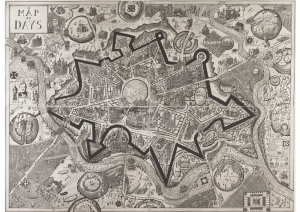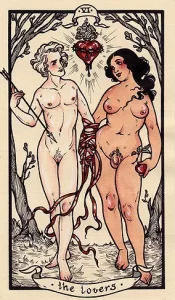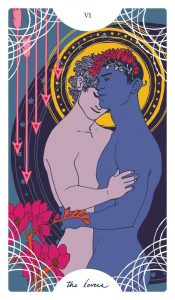I have always loved thresholds, and those liminal moments that precede the opening of a new chapter, or the beginning of a new year. One of life’s planners, in recent years I have embraced the time betwixt the midwinter festivities and the new year as a time for reflecting on what has been, dreaming what might be, and setting intentions for what is coming. My closest friend and I are developing a tradition of getting together (virtually for the last two years) to use workbooks and prompts like the Year Compass for this purpose, and to share our findings and dreams with each other.
So as spring begins to unfold for another year in the tenacious scrap of woodland opposite my front door, I thought I would share with you some of the more creative invitations I have extended to clients, or used myself, for mapping personal experiences and inner landscapes – for the purpose of reflection, integration, or setting intention, and sometimes all three. Like the tools my friend and I spend the last days of December grumbling and giggling over, these could be done solo, or shared with a close person or in a therapeutic setting if you so wish. All that is required are the writing/drawing implements of your choosing, a blank surface (give yourself plenty of space), and the permission to play.
Let’s start in the here and now. The following exercises are for those of you want to get a clearer sense of your own shape at this time:
Map of the inner landscape
Good for: Getting an overview of your inner landscape; taking a step back when you’re in personal process and/or therapy to see what you currently know about yourself; creating a self-portrait from the inside out.

When I think about this invitation, Grayson Perry’s Map of Days inevitably comes to mind – described on the National Portrait Gallery website as “a highly unusual self-portrait, taking the form of a map of a walled city. Areas in and around the city correspond to the life events, experiences and emotions of the artist”. Whether you choose to depict your inner world as a city, an island, an archipelago, or even a planet, the invitation is to map onto it the aspects of yourself you are currently aware of. Perhaps there’s a valley of love at the centre of your map, which is occasionally flooded with lava from a nearby volcano; perhaps that thing that happened when you were five takes up a whole island of its own that you know you’re going to need to visit someday; perhaps x marks the spot on still-buried treasure… Try not to judge or censor yourself; the object of the exercise is not to create something for someone else’s approval (or indeed your own), but instead to depict as much as you know about yourself in one place.
Things you might get curious about: How are different parts of the landscape related to each other, how are they connected? Which aspects of yourself take up more space on the map, and which less; which do you wish took up less space, and which more? What happens when you hang out in different parts of that landscape, how do you get there? Which areas are you familiar with, which ones are as yet uncharted?
Map of the present body
Good for: Getting an in-depth sense of how you are thinking, feeling, and being in your body in the moment; could also be used to gage your embodied response to a particular question or situation.
Draw an outline of your body onto a piece of paper – it does not have to be exact. With writing and colouring tools that you enjoy to hand, begin to place your awareness on different parts of your body, starting from the crown of the head, and travelling downwards through your body (e.g. crown, mind, face, jaw, throat, neck, and so on). You can use your breath to help you focus your attention. Whenever you encounter something that feels significant to you – a thought, feeling, sensation, or image – write or draw it where you found it in your body inside the outline. If your attention starts to slide, just acknowledge that and gently bring it back to what you were focusing on. If you haven’t done something like this before, try listening to each part of your body, breathing deeply, and waiting to see whether any words or impressions arise before moving on. Take your time, some parts of you may need longer to share what’s happening for them than others.
Things you might get curious about: What’s underneath that thought or feeling? What does that sensation have to say? What parts of you could talk all day, what parts don’t want to talk at all? Which parts are you used to paying attention to, and which ones are starved for your attention – and why?
With both of the exercises above, you could use them to do a one-off check-in, or you could keep adding to the map and allow it to change and evolve over time.
*
These next two creative prompts are for those of you who are looking ahead, and asking yourselves what you would like your next year or season to look like – and/or who you hope to be in your next chapter. I enjoy using nature-based images for these kind of reflections – organic shapes that speak to growth and blossoming, but also acknowledge our need to release and rest:
Mapping the tree of you
Good for: Getting a clearer vision of your current self, and/or visioning the self you are growing into.
This is probably the shape I’ve been using for this kind of reflective self-portrait for the longest time. I draw myself as a tree – and I’m inviting you to do the same. You could also use an existing image of a tree as a template if you wish. What you map onto the tree will likely depend on the intention or questions behind your reflecting; here are some of the things that have shown up on mine: Into the roots of the tree, I write reminders of the things that nourish me, and options for self-care, resourcing, and rest. Up in the branches I detail the projects I am working on, or the offerings I’m hoping to bring into the world. I usually place my heart in the centre of the tree, just before the trunk starts dividing into bigger branches; around my heart, I might write my main goals for the year, or perhaps the things that are especially dear to me in this chapter of my life. Take a moment to reflect on your intention for this portrait, and allow how you use this process to emerge from there.
Things you might get curious about: What supports your roots? Do you have enough support – how might you ask for more? How’s your trunk (this might represent your physical self, or your core identity)? How would you like it to be? What is blossoming or fruiting in your branches? What do you hope to harvest? Does that harvest feel sustainable for the rest of your tree-self?
Mapping your patch
Good for: Getting a sense of the current shape or state of your “patch”, your work, or your life’s purpose; identifying what needs more attention, what’s nourishing you, what’s ready to be released; creating wholistic plans of action.
In my book Igniting Intimacy: Sex Magic Rituals for Radical Living and Loving, in the Making Love with Earth section, I talk about the concept of tending our patch. I define our patch as “the place where our skillset, biases, and passions meet the needs of the world”. You could use this process to work on your patch, or to cultivate the garden of your life. Divide a piece of paper into four quadrants, entitled Plant, Nurture, Harvest, and Prune respectively. This is your patch or life garden. Feel free to doodle and decorate its borders as much as you wish while you reflect on which aspects of your work/service, or your life, need to fall into each quadrant. In the Plant quadrant, list or draw the seeds you are planting or hoping to plant and coax into (your) life. In the Nurture section, list projects, relationships, or experiences that are already underway, which you would like to tend to and encourage more of. In the Harvest section, list those things that are already yielding return, reward, resources, areas you can celebrate and draw nourishment or learning from. In the Prune (or Weed, or Cut Back) quadrant, list the things you know it’s time to let go of – the ties that need kindly cutting, the habits you’re done with, the experiences that you’ve learned all you needed to learn from and have no wish to repeat. And, of course, you may find you wish to add additional areas, or perhaps a water feature or apple tree laden with fruit – in which case, go for it!
Things you might get curious about: Are the number of things growing in each of your quadrants roughly equal, or are one or two of the quadrants overflowing when another barely has anything in it? Does your garden feel sustainable with the quadrants in this balance? Are you censoring or “should-ing” yourself as you make your lists – could you give yourself more permission to dream, to draw what you’re longing to plant or to uproot? Is something missing from your patch? Is something in your garden overgrown?
After playing with either of the prompts above, you may wish to list a few actions you could take – e.g. for better self-care, or to get closer to realising your dreams. Try and keep the list concise, specific, and achievable.
*
Finally, what about some creative ways to check in with or lavish some attention on your erotic self? Given the focus on my work, I’m often inviting clients to explore their intimate landscapes using these kinds of maps and structures, so I had a few to choose from. For this post, inspired by the art of Fyodor Pavlov (particularly his rendition of The Lovers tarot card) I’m settling on a particularly creative invitation for you:
The Erotic Self Triptych
Good for: Getting an overview of your erotic journey so far, celebrating how far you’ve come, and envisioning what pleasures and permissions you would like to blossom into next.
This one is inspired by a classic “quickie” spread in tarot: the Past, Present, Future spread. I probably don’t need to say more about that – it does what it says on the tin. My invitation to you is to create a series of portraits of your erotic self, a triptych similar to that spread, where the first portrait represents your erotic self in the past, the second in the present, and the third your erotic self as you dream and desire to be in the future. Hold up – I see a bunch of you turning away because you think you “can’t draw”. I’ll spare you my rant about how the Renaissance impacted our perceptions of art, and tied it to concepts like “talent” and “patronage” (and the privileges that attend both of those) and instead talk you through some of the things “portrait” could mean in this instance:
- A portrait could be made of words – a poem, a micro-fiction, a stream of consciousness on the page.
- A portrait could be a collage thrown together from images torn out of old magazines or cut from old cards or photos.
- A portrait could be a piece of movement, a dance to a particular song; you could make a three-track playlist a move your body from where you were to where you want to be.
- A portrait could use pre-existing images – of you, of people you admire, of fictional characters, of a work of art or a tarot card – which you then add to with words, doodling, or collage.
- And, yes, a portrait could be a drawing or painting or other “art form” that is as detailed or abstract, as playful or serious, as you feel drawn to make it.



Things you might get curious about: What point in time are you drawn to depict as your past self (e.g. when you hit puberty, when you were discovering your sexuality, a particularly pleasurable or painful moment in time, a period of time such as the span of a particular relationship or decade…)? Is there anything you miss about your past erotic self that you would like to incorporate into the present or future? Is there anything your past self needs from your current self to heal and integrate? How is your current erotic self feeling – is there anything they have to share with you, or anything they need from you or someone else? What do you dream of for your erotic self in the future? What or who might help you get there?
*
I hope you will find something in the above to inspire your reflective and creative process, or perhaps extend a little extra encouragement to your dreams and desires. If any of these processes stir up feelings or discoveries that feel like too much for you to hold alone, remember we all need more support than we think right now, and reach out for the help that you need; you are necessary, you are not alone, and you never know where that journey might take you.
Enjoy!
